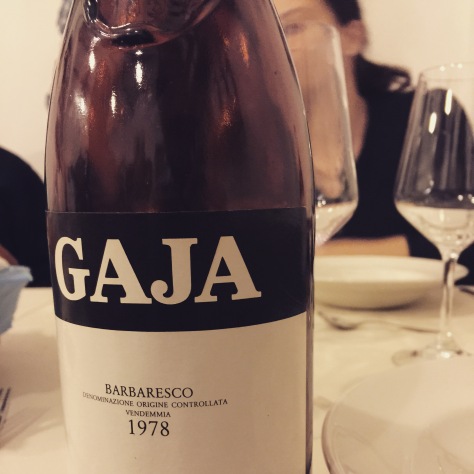
On September the 20th of September, I will be hosting at Scopri ‘best of barbaresco’ featuring 7 back vintage wines from Gaja and Bruno Giacosa. It should be an amazing night with the dinner already sold out.
Even though this dinner is sold out, over the course of the next few months, I will be hosting these themed dinners at Scopri which aim to educate and fascinate those who attend on just how great Italian wines can be. The dinners are limited to a maximum of ten people and it should be a blast!
 Strikingly profound and built to live for decades, Gaja’s wines display opulence and elegance unmatched elsewhere in Italy. These wines, while harnessing modern technology, have a long-established track record, ensuring they will perform well both in the glass and on the auction block. For any collector considering Italian wines, Gaja should be the first name on the list.
Strikingly profound and built to live for decades, Gaja’s wines display opulence and elegance unmatched elsewhere in Italy. These wines, while harnessing modern technology, have a long-established track record, ensuring they will perform well both in the glass and on the auction block. For any collector considering Italian wines, Gaja should be the first name on the list.

Bruno Giacosa, a man of few words but eloquent talent, practices an extremely simple philosophy based on the respect of traditions both in the vineyard and in the cellar. Giacosa brings out a richness of flavor and an intensity of character to produce wines of meditation. In addition to Bartolo Mascarello, and Giacomo Conterno, the Giacosa estate is the most respected producer of traditional style Barolo.

Where:
Scopri Food and Wine
191 Nicholson St
Carlton VIC 3053
Phone: 93478252
When:
Thursday September 20th at 7.30pm
Cost: $300 per head (this dinner sold out)
The wines featured on the night:
Angelo Gaja Barbaresco 1995
1995 tends to be a good rather than great vintage in Piedmont, but Gaja’s sensational 1995s are among the stars of the vintage. This wine possesses extremely saturated dark ruby/purple colors, almost atypical for Nebbiolo. The 1995 Barbaresco offers a superb nose of licorice, cherry fruit, strawberries, flowers, and toasty scents. Ripe, dense, and lush, with an alluring, sexy personality, it is one of the more forward, generic Barbarescos Gaja has produced. Anticipated maturity: now-2011. Importer: Vinifera Imports, Ronkonkoma, NY; tel. (516) 467-5907 90 points Robert Parker, Wine Advocate #124 Aug 1999
Angelo Gaja Barbaresco 1996
The 1996 Barbaresco exhibits a dense ruby color as well as a forward nose of cherry liqueur, earth, truffle, mineral, and spicy scents. Rich, full-bodied, and seductive, with its moderate tannin largely concealed by the wine’s wealth of fruit and extract, this gorgeously pure offering gets my nod as the finest Barbaresco produced by Gaja since 1990. Anticipated maturity: 2002-2016. As I reported in issue #124 (8-27-99), 1996 is a spectacular vintage for Angelo Gaja. 90 points Robert Parker Wine Advocate #130 Aug 2000
Angelo Gaja Barbaresco 1997
Gaja’s 1997 Barbaresco is undoubtedly the finest he has yet made. An exquisite effort, it boasts a dense ruby/purple color in addition to an extraordinary nose of black cherry liqueur, smoke, licorice, mineral, and floral aromas. The wine is full-bodied, opulent, and loaded with fruit. Despite its precocious nature, there is abundant tannin, and thus 3-4 years of cellaring is required. It should age effortlessly for 25 years.
A genius for sure, Angelo Gaja can not be faulted for what he puts in the bottle. This work of art is worth every cent it will fetch. Robert Parker 94 points, Wine Advocate #135 Jun 2001
Bruno Giacosa Santo Stefano Barbaresco Riserva 1988
The 1988 is the most advanced of these Santo Stefanos. It is fully mature, with notes of leather, tobacco, beef bouillon, prunes and spices on a medium-bodied frame with soft tannins and excellent length. There appears to be little upside in cellaring bottles any further and I would choose to drink my remaining bottles within the next few years. Antonio Galloni In the Cellar Apr 2007
Bruno Giacosa Barbaresco 1989
Bruno Giacosa’s wines are well represented in my personal cellar, which was the source for the vast majority of these bottles. I have had the good fortune to taste all of Giacosa’s 1989s and 1990s from multiple sources over the last year, and therefore can report that these notes are representative of what readers can expect from well-stored bottles. I consider 1989 and 1990 – along with 1978, 1982, 1996, 2001, 2004 and 2007 – to be among Giacosa’s finest vintages. Antonio Galloni Wine Advocate #187 Feb 2010
Bruno Giacosa Gallina di Neive Barbaresco 1990
The 1990 Barbareso Gallina is simply awesome. The wine boasts a seamless core of rich red fruits in a soft, generous style. This opulent Barbaresco possesses impeccable balance and tons of class. Floral notes intermingled with bright red fruits provide lift on the finish, adding lovely balance to the dense fruit. This is the most approachable of Giacosa’s 1990s but has plenty of stuffing to last another twenty years. The 1978 is still going strong. Anticipated maturity: 2010-2025. 94 points Antonio Galloni Wine Advocate #187 Feb 2010
Bruno Giacosa Falleto Barbaresco 1997 (imposter… 🙂
Giacosa’s 1997 Barolo Falletto de Serralunga is an exquisite Barolo offering superb notes of tar, earth, truffles, licorice, minerals, and cherry/raspberry fruit. There is plenty of acidity as well as high tannin, but concentrated, chewy flavors. The wine is tight, dense, impressive, and surprisingly structured for a 1997. Anticipated maturity: 2003-2025. 93 points Robert Parker Wine Advocate #135 Jun 2001



























